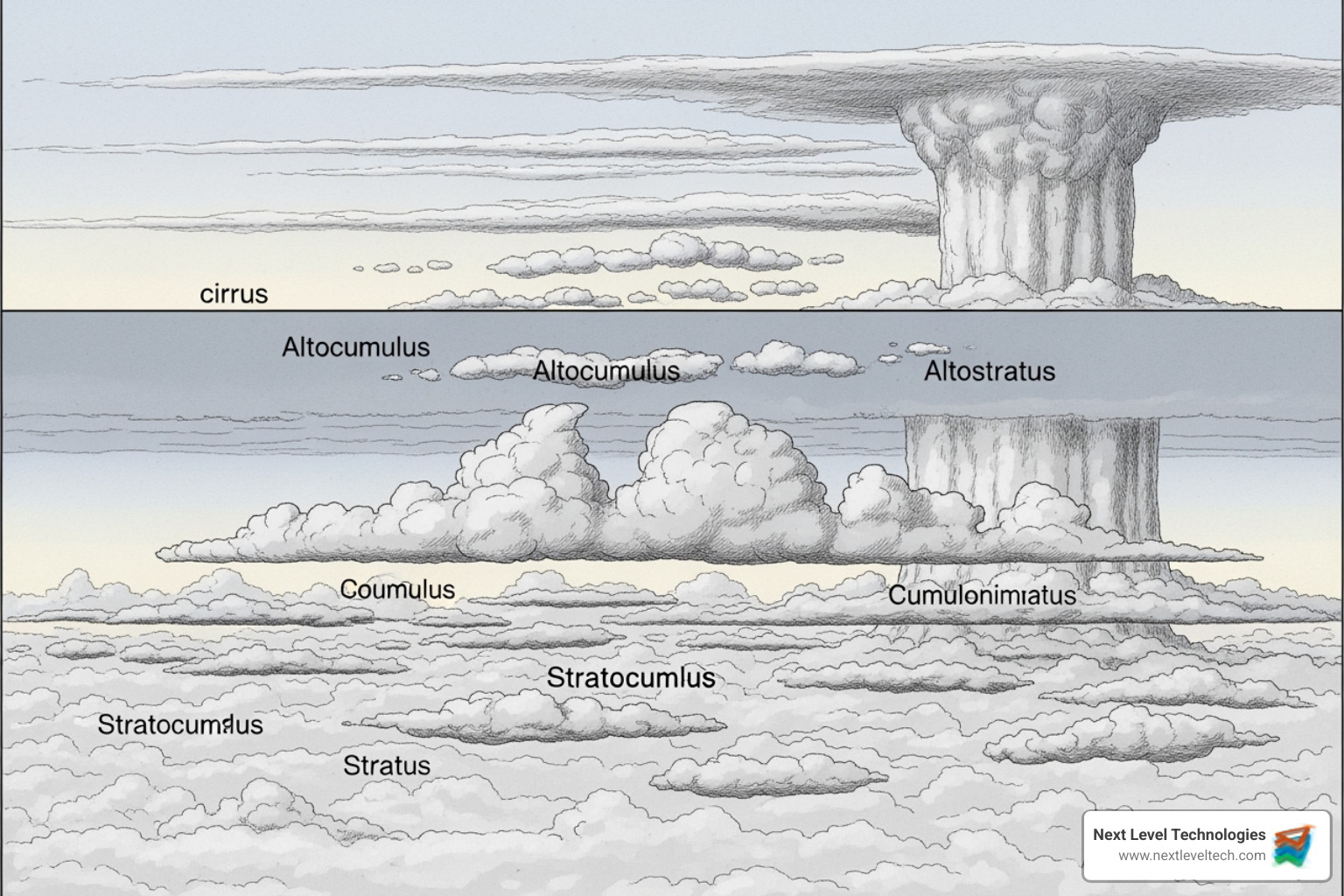What is Cloud Cover? From Atmospheric Phenomenon to Business Solutions
November 25, 2025

Explore "cloud cover" from weather to tech. Understand its impact & secure your business's digital cloud solutions.
November 25, 2025

Unlock microsoft work from home insights. Learn about their hybrid model, technology, and flexible career paths for employees.
November 21, 2025

Find expert IT Service Providers in Columbus Ohio. Secure your business, optimize tech, and drive growth with a trusted local partner.
November 20, 2025
November 25, 2025
The term cloud cover refers to two distinct but equally important concepts: the meteorological phenomenon of clouds in the sky and the technology infrastructure that powers modern business.
Atmospheric Cloud Cover:
Technology "Cloud" Cover:
In meteorology, cloud cover is a key factor in weather forecasting and climate studies. About 67-68% of Earth is covered by clouds at any given time, acting as a natural thermostat by reflecting sunlight and trapping heat.
In technology, "the cloud" is an invisible network of remote servers that run applications and store data, eliminating the need for on-site hardware. For businesses struggling with outdated systems, understanding this digital cloud cover is essential for survival.
The challenge is that just as meteorologists need tools to predict weather, businesses need expert guidance to steer cloud computing, data security, and compliance. A piecemeal approach to IT creates vulnerabilities, system failures, and costly inefficiencies.
I'm Steve Payerle, President of Next Level Technologies. Since 2009, my team has helped hundreds of businesses in Columbus, Ohio, and Charleston, WV, transition from unreliable IT to secure, professionally managed cloud solutions. Whether atmospheric or digital, understanding cloud cover is about preparing for the future and protecting what matters.

Cloud cover is the fraction of the sky obscured by clouds at any moment. It’s fundamental to our weather and planet's habitability. Clouds form when water vapor in the air cools and condenses into visible droplets or ice crystals, a process dependent on temperature, moisture, and atmospheric pressure.
Clouds are Earth's climate control system. During the day, they reflect sunlight, keeping temperatures cool. At night, they trap heat radiating from the surface, which is why a cloudy night in Columbus or Charleston often feels warmer than a clear one. The Glossary of Meteorology defines cloud cover as the fraction of the sky obscured by clouds.

Meteorologists quantify cloud cover using the okta scale, which divides the sky into eight equal parts (0 oktas for clear, 8 for overcast). This is often converted to percentages (0-100%). Measurements are taken by trained ground observers, ground-based instruments like ceilometers that use lasers, and satellites that provide a big-picture view.
Weather apps translate these measurements into familiar terms:
"Mostly sunny" implies less cloud cover (2/10 to 3/10), while "mostly cloudy" suggests more (7/10 to 8/10).
A cloud's altitude determines its type and the weather it might bring.
Globally, the typical base of cloud cover is around 4,000-5,000 meters, but this varies significantly with latitude. Understanding these altitudes is crucial for weather prediction.
Cloud cover is a massive, interconnected system that shapes our planet's climate. Clouds act as a thermostat, reflecting sunlight (the albedo effect) to cool the Earth and trapping heat to warm it. At any moment, about 67-68% of the Earth is covered by clouds. This coverage is higher over oceans (72%) than over land (55%), where it varies more with the seasons.
NASA's "Cloud Fraction" global map allows you to explore these patterns, which are vital for climate science.
The amount of cloud cover depends heavily on geography. Desert regions see 10-15% less cloud cover than average, while stormy southern latitudes can see 15-25% more.
In our service areas of Columbus, Ohio, and Charleston, West Virginia, we see moderate cloud cover with distinct seasonal changes.
These local patterns contrast with the famously cloudy Pacific Northwest and the mostly clear Southwest, shaping daily life and regional characteristics.
Cloud cover directly impacts the bottom line for many industries. Accurate meteorological data is crucial for planning and risk reduction.
Just as atmospheric cloud cover is a vast, dynamic system, the technology "cloud" is a transformative infrastructure for modern business. It provides computing resources from remote data centers, accessible anywhere with an internet connection. Instead of relying on an aging on-site server, cloud computing gives you access to enterprise-grade data centers with superior redundancy and security.
The key advantages are scalability, flexibility, and cost-effectiveness. You can adjust resources on demand, avoiding the cost of purchasing and maintaining hardware that often sits idle.
Since 2009, Next Level Technologies has guided businesses in Columbus, OH, and Charleston, WV, through this transition. Our team's extensive technical expertise and cybersecurity training help companies move from unreliable IT to professionally managed cloud solutions, freeing them to focus on their core business. Learn more about the fundamentals on our Cloud Computing and Software as a Service page.

The digital cloud offers several service models to meet different business needs.
Cloud backup is a critical service that protects your business from disaster. Unlike traditional methods, it stores encrypted copies of your data in secure, off-site data centers. This ensures you can recover from ransomware, hardware failure, or physical damage. We cover this vital protection on our Cloud Backup for Small Business page.
Properly implementing these services requires significant technical expertise, which is why our team maintains extensive cybersecurity training. For a complete overview, visit our Cloud Services for Businesses explained guide.
Managing your digital cloud cover is as complex as predicting the weather. The technology landscape and cyber threats evolve daily. While a missed weather forecast might get you wet, a gap in cloud security can lead to data loss, regulatory fines, and devastating downtime.
Many businesses in Columbus, Ohio, and Charleston, WV, adopt cloud services piecemeal, creating a weak security foundation. Key challenges include:
Proactive management is essential. Reacting to problems is costly and disruptive. Our guide on Cloud Security Best Practices outlines how to stay ahead of threats.
Securing your digital cloud cover requires both advanced technology and human expertise.
AI and machine learning tools provide 24/7 monitoring to detect anomalies and threats that humans would miss. However, technology alone is not enough. This is where the value of a Managed Service Provider (MSP) becomes clear. Most businesses lack the resources for a dedicated in-house team of cybersecurity experts.
Next Level Technologies acts as your dedicated IT department. Our team's deep technical experience allows us to provide enterprise-level security to businesses in Columbus, OH, and Charleston, WV. We focus on proactive threat detection through continuous monitoring, security assessments, and multi-layered defenses.
What truly sets us apart is our commitment to extensive cybersecurity training. Our staff undergoes rigorous, continuous education to stay ahead of emerging threats. This combination of technical experience and up-to-date training allows us to defend against even the most sophisticated attacks. Partnering with us gives you a team of experts dedicated to your security. Explore our Cloud IT Security services to learn more.
Let's tackle some common questions about both atmospheric and digital clouds.
Meteorologists use the Okta scale to measure atmospheric cloud cover, dividing the sky into eight parts (0/8 for clear, 8/8 for overcast). This is translated into descriptive terms like "clear," "partly cloudy" (a mix of clouds and sun), "mostly cloudy," and "overcast" (a solid gray blanket). These classifications are vital for industries like aviation and agriculture.
Atmospheric cloud cover acts as Earth's thermostat.
The overall effect depends on the cloud's type, altitude, and thickness.
This is a critical distinction for business owners in Columbus and Charleston.
At Next Level Technologies, our team's extensive technical experience and cybersecurity training help businesses in Columbus and Charleston implement the right mix of cloud services securely. We ensure you have both the operational power of cloud computing and the critical protection of cloud backup.
From the atmospheric clouds that shape weather in Columbus, Ohio, and Charleston, West Virginia, to the digital infrastructure that powers modern business, cloud cover plays a fundamental role in our lives. Atmospheric clouds are a critical part of our climate system, while the digital "cloud" offers businesses best scalability and flexibility.
However, this digital power comes with risks. Without proper management, the accessibility of the cloud creates vulnerabilities. Many businesses struggle with piecemeal IT solutions, leaving them exposed to security gaps, downtime, and compliance failures. Managing this complexity requires more than good intentions; it demands a partner with deep technical experience and rigorous cybersecurity training.
At Next Level Technologies, we have spent over a decade helping businesses transition from unreliable IT to secure, professionally managed cloud solutions. Our proactive, strategic guidance ensures your digital infrastructure is both powerful and protected.
While the sky's cloud cover manages itself, your business's digital cloud requires active management and constant vigilance. Don't leave your operations exposed to digital storms.
Contact us to learn how our Managed IT Services and IT Support can secure your business's cloud and provide the peace of mind to focus on running your business.
Unlock microsoft work from home insights. Learn about their hybrid model, technology, and flexible career paths for employees.
November 21, 2025
Find expert IT Service Providers in Columbus Ohio. Secure your business, optimize tech, and drive growth with a trusted local partner.
November 20, 2025
Next Level Technologies was founded to provide a better alternative to traditional computer repair and ‘break/fix’ services. Headquartered in Columbus, Ohio since 2009, the company has been helping it’s clients transform their organizations through smart, efficient, and surprisingly cost-effective IT solutions.
